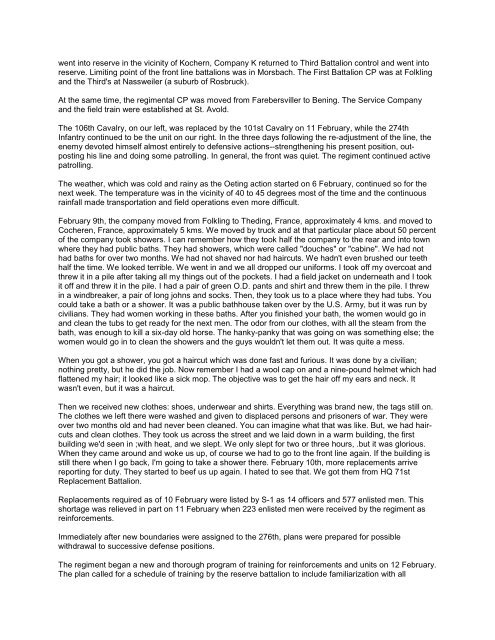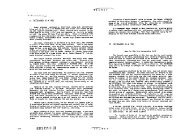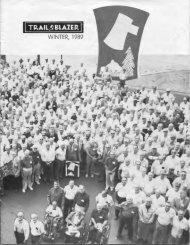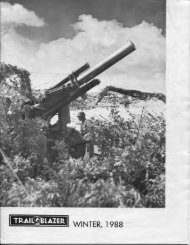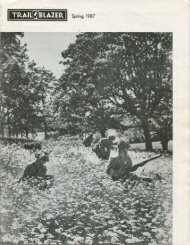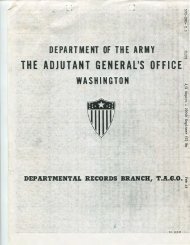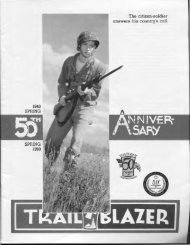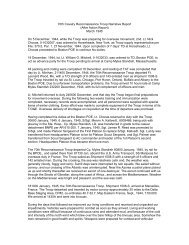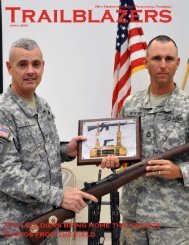Download - 70th Infantry Division Association
Download - 70th Infantry Division Association
Download - 70th Infantry Division Association
Create successful ePaper yourself
Turn your PDF publications into a flip-book with our unique Google optimized e-Paper software.
went into reserve in the vicinity of Kochern, Company K returned to Third Battalion control and went into<br />
reserve. Limiting point of the front line battalions was in Morsbach. The First Battalion CP was at Folkling<br />
and the Third's at Nassweiler (a suburb of Rosbruck).<br />
At the same time, the regimental CP was moved from Farebersviller to Bening. The Service Company<br />
and the field train were established at St. Avold.<br />
The 106th Cavalry, on our left, was replaced by the 101st Cavalry on 11 February, while the 274th<br />
<strong>Infantry</strong> continued to be the unit on our right. In the three days following the re-adjustment of the line, the<br />
enemy devoted himself almost entirely to defensive actions--strengthening his present position, outposting<br />
his line and doing some patrolling. In general, the front was quiet. The regiment continued active<br />
patrolling.<br />
The weather, which was cold and rainy as the Oeting action started on 6 February, continued so for the<br />
next week. The temperature was in the vicinity of 40 to 45 degrees most of the time and the continuous<br />
rainfall made transportation and field operations even more difficult.<br />
February 9th, the company moved from Folkling to Theding, France, approximately 4 kms. and moved to<br />
Cocheren, France, approximately 5 kms. We moved by truck and at that particular place about 50 percent<br />
of the company took showers. I can remember how they took half the company to the rear and into town<br />
where they had public baths. They had showers, which were called "douches" or "cabine". We had not<br />
had baths for over two months. We had not shaved nor had haircuts. We hadn't even brushed our teeth<br />
half the time. We looked terrible. We went in and we all dropped our uniforms. I took off my overcoat and<br />
threw it in a pile after taking all my things out of the pockets. I had a field jacket on underneath and I took<br />
it off and threw it in the pile. I had a pair of green O.D. pants and shirt and threw them in the pile. I threw<br />
in a windbreaker, a pair of long johns and socks. Then, they took us to a place where they had tubs. You<br />
could take a bath or a shower. It was a public bathhouse taken over by the U.S. Army, but it was run by<br />
civilians. They had women working in these baths. After you finished your bath, the women would go in<br />
and clean the tubs to get ready for the next men. The odor from our clothes, with all the steam from the<br />
bath, was enough to kill a six-day old horse. The hanky-panky that was going on was something else; the<br />
women would go in to clean the showers and the guys wouldn't let them out. It was quite a mess.<br />
When you got a shower, you got a haircut which was done fast and furious. It was done by a civilian;<br />
nothing pretty, but he did the job. Now remember I had a wool cap on and a nine-pound helmet which had<br />
flattened my hair; it looked like a sick mop. The objective was to get the hair off my ears and neck. It<br />
wasn't even, but it was a haircut.<br />
Then we received new clothes: shoes, underwear and shirts. Everything was brand new, the tags still on.<br />
The clothes we left there were washed and given to displaced persons and prisoners of war. They were<br />
over two months old and had never been cleaned. You can imagine what that was like. But, we had haircuts<br />
and clean clothes. They took us across the street and we laid down in a warm building, the first<br />
building we'd seen in ;with heat, and we slept. We only slept for two or three hours, .but it was glorious.<br />
When they came around and woke us up, of course we had to go to the front line again. If the building is<br />
still there when I go back, I'm going to take a shower there. February 10th, more replacements arrive<br />
reporting for duty. They started to beef us up again. I hated to see that. We got them from HQ 71st<br />
Replacement Battalion.<br />
Replacements required as of 10 February were listed by S-1 as 14 officers and 577 enlisted men. This<br />
shortage was relieved in part on 11 February when 223 enlisted men were received by the regiment as<br />
reinforcements.<br />
Immediately after new boundaries were assigned to the 276th, plans were prepared for possible<br />
withdrawal to successive defense positions.<br />
The regiment began a new and thorough program of training for reinforcements and units on 12 February.<br />
The plan called for a schedule of training by the reserve battalion to include familiarization with all


